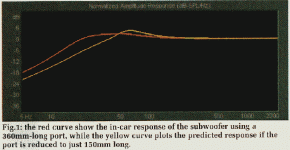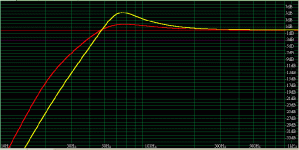Hi
I've been playing around with various driver specs and WinISD beta .44. It seems like an easy to use program with good help files.
My question to the old heads here is: how reliable, accurate or satisfactory is WinISD for calculating designs?
If you don't consider it does an effective job then why? and which software is best to use and why? Please keep in mind that there's a lot of guys like me who are interested in simply building solid, clean-sounding loudspeakers and who may not be interested in esoteric designs or the minutae of the art.
Thanks in advance.
Mos
I've been playing around with various driver specs and WinISD beta .44. It seems like an easy to use program with good help files.
My question to the old heads here is: how reliable, accurate or satisfactory is WinISD for calculating designs?
If you don't consider it does an effective job then why? and which software is best to use and why? Please keep in mind that there's a lot of guys like me who are interested in simply building solid, clean-sounding loudspeakers and who may not be interested in esoteric designs or the minutae of the art.
Thanks in advance.
Mos
they all use the same formulas, so u will get the same results. i suggest using winisd pro alpha, it has more options.. the biggest advantage of programs like bass box, is that you can enter in the transfer function or your car or room, and it will take that into account in the total frequency response.. winisd just shows freq resp of the speaker free-air
-chris
-chris
zx3chris said:the biggest advantage of programs like bass box, is that you can enter in the transfer function or your car or room, and it will take that into account in the total frequency response.. winisd just shows freq resp of the speaker free-air
-chris
Hmm, so, that would explain the extended bass on the graph done by bass box?
the biggest advantage of programs like bass box, is that you can enter in the transfer function or your car or room.
Subwoofer Simulator can also accept listening room transfer functions. Best of all SubSim is free.
Hmm, so, that would explain the extended bass on the graph done by bass box?
I doubt it, real curves are jagged and even smoothed out graphs are at least a bit squigly. The difference is due to the different port dimensions (as was written on the screenshot).
As was already said, the key to good program output is good input data. Programs similar to SubSim, winISD, Unibox, BB6 etc. all use small signal models -- enough to give you an idea of your design's real-world performance. With small-signal models, the predictions are valid within the driver's linear performance. Better still if your program is similar to SoundEasy, LEAP and so on... All of which can take into consideration driver unit non-linearities for large-signal modeling.
Cheers
Isaac
Best one I've found is LSPCad Lite for Windows. As long as you have all the necessary TS specs, there's a large amount of configration that can be done with this program.
WinISD has a newer alpha version in the testing phase that shows some promise, but its still extremely buggy.
Isaac, need to add some configurability to Sub Sim I like having the optimal box spit out, but sometimes the optimal box is over 1000L! (not an error in the program)
I like having the optimal box spit out, but sometimes the optimal box is over 1000L! (not an error in the program)
WinISD has a newer alpha version in the testing phase that shows some promise, but its still extremely buggy.
Isaac, need to add some configurability to Sub Sim
Isaac, need to add some configurability to Sub Sim I like having the optimal box spit out, but sometimes the optimal box is over 1000L! (not an error in the program)
If you meant box optimization, I just started working on it again after almost a year of setting it aside. The old code works, but I'm just not satisfied with the optimization speed when it comes to 6th/8th-order band-pass boxes. (Yep, a huge box is an indication that the driver unit in question was designed to be used in freeair.)
Version 2 of SubSim is under construction and it is about 80% finished. I'm just waiting for some of my new ideas to work/fail before I continue to write the remaining 20% of the code.
Cheers
Isaac
- Status
- This old topic is closed. If you want to reopen this topic, contact a moderator using the "Report Post" button.
- Home
- Loudspeakers
- Multi-Way
- Reliability of WINISD

